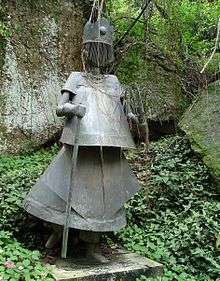Ọya
Ọya (Yoruba: Ọya, also known as Oyá or Oiá; Yansá or Yansã; and Iansá or Iansã in Latin America) is an orisha of winds, lightning, and violent storms, death and rebirth.[1] She is similar to the Haitian god Maman Brigitte, who is syncretised with the Catholic Saint Brigit.
| Ọya | |
|---|---|
Storms, Cemeteries, Marketplace | |
| Member of Orisha | |
 Iansã Sculpture at the Catacumba Park, Rio de Janeiro, Brazil | |
| Other names | Oyá or Oiá; Yansá or Yansã; and Iansá or Iansã |
| Venerated in | Yoruba religion, Umbanda, Candomble, Quimbanda, Santeria, Haitian Vodou, Folk Catholicism |
| Symbol | lightning, the sword or machete, the flywhisk, water buffalo |
| Color | purple or burgundy, the rainbow |
| Region | Nigeria, Benin, Latin America |
| Ethnic group | Yoruba |
| Personal information | |
| Spouse | Shango |
In Yoruba, the name Oya means "she tore."[2] She is known as Ọya-Iyansan – the "mother of nine" — due to the Niger River (known to the Yoruba as the Odo-Ọya) traditionally being known for having nine tributaries.[3]
Candomblé
In Candomblé, Oya is known as Oiá, lyá Mésàn, or most commonly, Iansã, from the Yoruba Yánsán. Iansã, as in Yoruba religion, commands winds, storms, and lightning. She is the queen of the river Niger, and the mother of nine. She is a warrior and is unbeatable. Attributes of Iansã include great intensity of feelings, sensations, and charm. Another ability attributed to Iansã is control over the mysteries that surround the dead.[4] Iansã is syncretized with Saint Barbara.[5] In the Candomblé nação (association) of Angola Congo, Iansã is associated with the colour red.[6]
Characteristics
Ritual foods
Acarajé, a ball formed from crushed or peeled beans and fried in dendê (palm oil) is a traditional offering to Iansã in the Candomblé tradition of Brazil. A simple, unseasoned form of acarajé is used in rituals, and a version served with various condiments is sold as a common street food in Bahia in the northeast of Brazil. Ipeté and bobo de inhame are also associated with Iansã.[6]
See also
Bibliography
- Judith Gleason, Oya, San Francisco: Harper, 1992 (Shamballah, 1987), ISBN 0-06-250461-4
- Charles Spencer King, Nature's Ancient Religion, ISBN 978-1-4404-1733-7
References
- Adeoye, C. L. (1989). Ìgbàgbọ́ àti ẹ̀sìn Yorùba (in Yoruba). Ibadan: Evans Bros. Nigeria Publishers. p. 303. ISBN 9781675098.
- Machacek, David W., and Melissa M. Wilcox, eds. (2003). Sexuality and the World's Religions. ABC-CLIO. ISBN 9781576073599. Retrieved 24 September 2012.CS1 maint: uses editors parameter (link)
- A Bahia de Santa Bárbara Archived 22 November 2005 at the Wayback Machine
- Obaràyí : babalorixá Balbino Daniel de Paula. Salvador, Bahia, Brasil: Barabô Design Gráfico e Editora. 2009. p. 568. ISBN 9788562542008.
- Henry, Clarence Bernard (2008). Let's Make Some Noise: Axé and the African Roots of Brazilian Popular Music. Jackson, Mississippi: University Press of Mississippi. ISBN 9781604730821.
- Barbosa, Ademir (2015). Dicionário de Umbanda. São Paulo: Anubis. pp. 108–109, 240. ISBN 9788567855264.
- Araujo, Carlos de (1993). ABC dos orixás (in Portuguese). Rio de Janeiro, RJ: Nordica. pp. 72–74. ISBN 9788570072252.